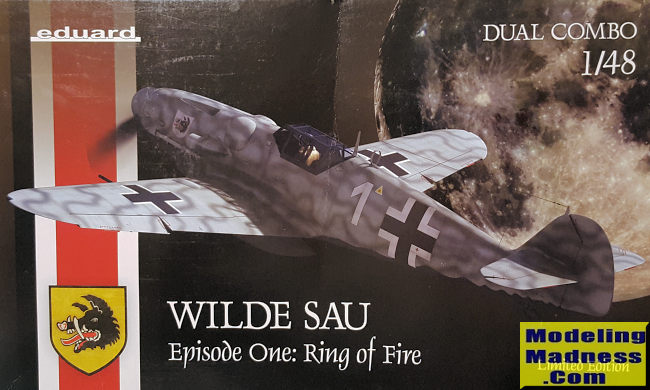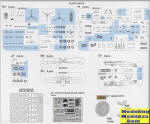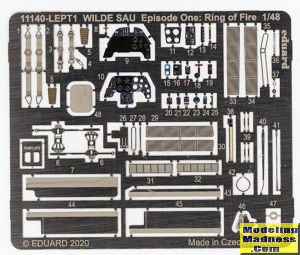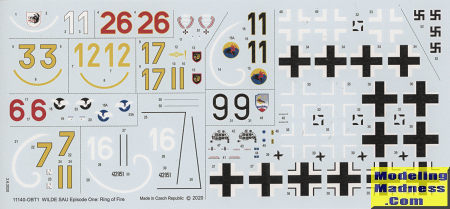
| KIT #: | 11140 |
| PRICE: | $89.00 SRP |
| DECALS: | Ten options |
| REVIEWER: | Scott Van Aken |
| NOTES: | Two complete kits with p.e. and resin. |

| HISTORY |
On 27 June 1943, Luftwaffe officer Major Hajo Herrmann proposed an experimental approach to counter Allied night bombing. His proposal, which he had tested in trials secretly, was picked up and expanded by Viktor von Loßberg, by prepared reports from his staff group. Loßberg presented his proposal on 29 July, before the Luftwaffe leadership, Erhard Milch and Hermann Göring. The successful trial runs of the new tactic convinced them and especially Hitler to officially put this doctrine into use.
The new tactic outlined in Herrmann's report envisaged the use of free-ranging day fighters (and to a lesser extent night fighters) to counter Bomber Command. The single-engined fighters were to supplement the ground controlled Himmelbett (four-poster bed) technique, by co-operation with searchlight crews, mostly over the target. Pyrotechnic and other visual means were to guide the fighters in operations known as Wilde Sau (Wild Boar). After the fighters had reached the combat zone, pilots tried to identify and intercept enemy bombers visually; searchlights were to be used to illuminate the sky. Initial tests using former flying instructors experienced in blind-flying techniques, suggested the ideal weather conditions were when a certain (not too thick) lower level cloud cover prevailed, since then the bomber would be silhouetted against the back-lit clouds and the high-flying German fighters could easily spot their targets.
During trials, ceasefires with the German flak units were arranged, to prevent friendly fire but it became apparent that co-ordination of ceasefires with Wilde Sau operations was difficult. To remove this threat from their own flak, the fighters were limited to certain altitudes, so the German flak could avoid firing on them. Another problem was navigation. As night-flying aids in a day fighter were rudimentary, an elaborate system of visual aids to navigation had to be established, encompassing light beacons, searchlight patterns, flak guns firing combinations of various tracer colours through the clouds and parachute flares. To make up for the lack of visual aids initially, converted bomber pilots had to be used, because they already had experience with navigating at night. Another navigation aid was simply the Allied bombing target; a city illuminated as it burned would guide the fighters to their target.
| THE KIT |
 This
is one of Eduard's double kits that provides two complete Profipak offerings.
This means you get photo etch (mostly for the interior), canopy and wheel masks,
as well as some resin parts. In this case, the resin consists of mainwheels and
some oversize exhaust stacks that are applicable to one of the options.
This
is one of Eduard's double kits that provides two complete Profipak offerings.
This means you get photo etch (mostly for the interior), canopy and wheel masks,
as well as some resin parts. In this case, the resin consists of mainwheels and
some oversize exhaust stacks that are applicable to one of the options.
 The kits
provided are basically their Bf-109G-6 (early). Only one of the markings options
has the taller fin/rudder and all of them have the early canopy. As mentioned, a
fair amount of the photo etch is for the interior in the form of seat harness,
rudder pedals, trim wheel chain, some placards, as well as the instrument
panels. You don't have to use all of the p.e. options and can use plastic parts
in their place if you so wish. In terms of the instrument panels, decals are
provided as well.
The kits
provided are basically their Bf-109G-6 (early). Only one of the markings options
has the taller fin/rudder and all of them have the early canopy. As mentioned, a
fair amount of the photo etch is for the interior in the form of seat harness,
rudder pedals, trim wheel chain, some placards, as well as the instrument
panels. You don't have to use all of the p.e. options and can use plastic parts
in their place if you so wish. In terms of the instrument panels, decals are
provided as well.
This same optional ability is offered for the exhaust where you can use the p.e. for the exhaust shields or the one piece plastic ones. Note that not all markings options use the same p.e. shields so follow the instructions. As mentioned the fin/rudders are not all the same and Eduard provides separate control surfaces for the rear, though they are designed to be modeled in the neutral position.
When building the wings, note that all but one of the markings options have the 20mm gun pods so you will need to open the holes for those. Separate flaps, slats, and radiator exhaust flaps are provided. You also have a choice of p.e. or plastic radiator screens. When doing the head armor, there are a variety of options and are dependent again on your choice of markings option. Canopy can be posed open or closed. Finally, on the underside, there are options for the centerline tank, though these are not markings specific.

 Instruction
booklet is very well done and it behooves the builder to pay close attention to
the notes within to ensure the best accuracy of the option being done. There are
ten different markings options, all from JG 300/301/302. Half of the options
have black undersides so that will be rather neat. You get a very large decal
sheet along with two others (not shown) that have stencils. I should mention
that for the options with the painted over insignia, you have to apply a
standard insignia and paint it over yourself.
Instruction
booklet is very well done and it behooves the builder to pay close attention to
the notes within to ensure the best accuracy of the option being done. There are
ten different markings options, all from JG 300/301/302. Half of the options
have black undersides so that will be rather neat. You get a very large decal
sheet along with two others (not shown) that have stencils. I should mention
that for the options with the painted over insignia, you have to apply a
standard insignia and paint it over yourself.
| CONCLUSIONS |
These double kits are a fairly good deal if you were going to buy aftermarket p.e. and masks anyway. They also usually include a bonus and in this case it was a small enameled pin with a wilde sau emblem on it. I've not built an Eduard 109G so cannot compare it to the Hasegawa and Tamiya versions, but I'm thinking it won't build as well as the Tamiya as the Eduard kit has a lot of small parts which will really only make the build more fiddly.
| REFERENCES |
https://en.wikipedia.org/wiki/Wilde_Sau
October 2021
Copyright ModelingMadness.com. All rights reserved. No reproduction in part
or in whole without express permission. Thanks to
for the review kit. You can find this kit at your favorite hobby shop
or on-line retailer. If you would like your product reviewed fairly and fairly quickly, please
contact
the editor or see other details in the
Note to
Contributors. Back to the Main Page
Back to the Review
Index Page
Back to the Previews Index Page